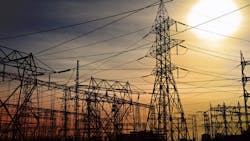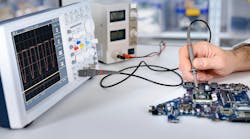Bringing High Power Density to Energy Harvesting
This article explores innovations in energy harvesting in conjunction with wireless systems. Free-standing magnetic field energy harvesters (FSMFEHs) open the door to optimized designs, leading to increased power and density levels. This capability can result in smaller PCB footprints by using a more optimized magnetic force. Designers will discover how FSMFEH technology will forever improve sensor power in the power grid.
What is Energy Harvesting?
Energy harvesting is also referred to as energy scavenging, power harvesting, or ambient power. It’s the process in which energy is taken from external sources (such as solar energy, thermal energy, wind energy, and kinetic energy, also known as ambient energy). This energy can be stored for use by small, wireless autonomous devices, such as wearable electronics, and wireless sensor networks (WSNs). WSNs can measure environmental conditions such as temperature, sound, pollution levels, humidity and wind.
Energy harvesters usually provide a very small amount of power for low-energy electronics, utilizing the energy that’s present in ambient background. For example, temperature gradients exist from the operation of a combustion engine, and in urban areas, a large amount of electromagnetic energy in the environment is due to radio and television broadcasting.
Wireless Sensor Networks in Industrial Automation
Wireless sensor communications, deployed within industrial applications, have virtually taken over plant and factory process automation. One of many good reasons to use wireless sensors is the rapid increase of smart devices and the expanding ecosystem of the Internet of Things (IoT) coupled with the unstoppable surge in demand for bandwidth-intensive applications. Wi-Fi 7 finds itself charged with the formidable challenge of enabling a far more efficient and responsive wireless experience for all users.
WSNs often cost much less than wired solutions, especially in industrial applications. Using wireless sensors enables a far easier means of tracking down a defect/fault within a wireless sensor network. That’s because a wired factory floor is frequently burdened with miles of buried wiring.
In addition, wireless is far more flexible than wired options. It allows for faster and easier reconfiguration of a network to meet constantly changing plant needs, which leads to adjusting to newer product varieties and models.
The Free-Standing Magnetic Field Energy Harvester (FSMFEH)
A magnetic field energy harvester (MFEH) will directly generate electricity via capturing the energy from a magnetic field that’s surrounding busbars. An FSMFEH2,4,8 can be mounted at any position on power busbars that carry current with an alternating magnetic field. The core of an FSMFEH rarely will saturate, leading to a very reliable system.
On the negative side, two issues must be addressed for the FSMFEH:
- The power density of the FSMFEH system is only at a µW/cm3 level
- Because the output power of the FSMFEH system is directly related to each parameter of the coil and core, the mathematical model for the output power of the FSMFEH system needs to be derived. The specific effects of every parameter of the core and coil on the output power of the FSMFEH system require a more detailed analysis.
Improving the FSMFEH System Output Power
The FSMFEH system output power is closely linked to the magnetic flux collection capability of the core.7 Consequently, the structural design of the core is crucial.
The influence of the coil and core parameters on the output power is quite significant for the FSMFEH. When the FSMFEH gets applied to busbars, the optimization of these coil and core parameters will be critical for the improvement of the output power.
The design of the corresponding coil parameters along with the specific parameters of the core will be difficult to analyze through simulation. This is because the simulation will take a great deal of time to analyze the data and summarize the rules. So, we find that it’s not clear whether the influence of every parameter of the FSMFEH on the output power will be monotonically linear or if there will be an optimal value, and the parametric design basis of FSMFEH is missing.
To solve this issue, an accurate mathematical model output power of FSMFEH will be established and derived below.
This accurate mathematical model of the output power, regarding the core and coil parameters, is based on an H-shaped core. According to this mathematical model, every core and coil parameter may be analyzed in detail. The optimal choice of these parameters is easily obtained; it will be able to provide the theoretical basis for the power improvement of the FSMFEH. Optimizing these parameters greatly improves the power density.
Key Contributors for an Accurate FSMFEH Mathematical Model
The leading technical contribution here establishes and derives, for the first time, an accurate power output mathematical model of the FSMFEH through the quantification of the coil mutual inductance, along with its internal resistance as core and coil parameters.7 In conformity with the mathematical model, the importance of each parameter, like the length of the core column, the side length of the core column, the number of turns in the coil, and the diameter of the coil wire, on the power density may now be analyzed. This will provide a design basis for optimization of the core and coil parameters.
The second most important contribution here is that the following design rules are discovered through analysis to create a higher power density under the set conditions:
- The thickness of the core lamination should be designed as thin as possible.
- The number of turns should be designed as much as possible.
- The values of the coil diameter and side length of the core column exist as optimal choices.
The third most important contribution is based on the optimization design of every parameter, with an H-shaped core having a volume of 3.168 cm3, and the quantity of turns in its coils are designed. This can lead to a power density of 4.182 mW/cm3 with a busbar current of just 100 A.
Energy Harvesting for Wireless Switches
Energy-harvesting switches (see figure) are able to transform the mechanical input energy of the switch actuation into electrical energy.8 This design is suitable when lower installation and maintenance costs, better flexibility, along with system uptime are needed, and when wiring doesn’t work in some designs.
Energy-harvesting wireless switches are an excellent a possible solution for explosion-proof applications due to their inherent low-power operating characteristics. This makes it possible to avoid the usage of intrinsically safe barriers, encapsulation, or other expensive protection methods.
Energy-Harvesting Modules for Low-Power Designs
Advanced Linear Devices’ EH300/EH301 Series EPAD ENERGY HARVESTING Modules are specifically designed for low power applications,9 with intermittent duty use and a long storage time for energy-harvesting apps. These modules are completely self-powered and will always be in the active mode.
This device series has excellent onboard features that enable energy accumulation and capture, storage of that energy, power conditioning, and energy management from such energy sources as:
- Solar cells
- PZT piezoelectric ceramic composite elements
- Inductive elements
- Micro thermo-electric generators
Going Wireless in Energy Harvesters
Improvements in low-power and reliable wireless communications, along with growth in sensor and energy-harvesting technologies, are leading to more practical and more efficient use of wireless communications instead of using a wired infrastructure.
References
1. Energy Harvesting Powers Wireless Sensor Networks In Industrial Apps.
3. ALD Energy Harvesting Modules (aldinc.com).
5. Bubbler: A Novel Ultra-High Power Density Energy Harvesting Method Based on Reverse Electrowetting.
6. Wireless Power Transfer and Energy Harvesting: Current Status and Future Prospects, NIST.
7. “An Accurate Power Model and High Power Density Design Method of Free-Standing Magnetic Field Energy Harvesters With H-Shaped Core,” Huanyu Yang, Yong Li, Senior Member, IEEE, Zhaowei Liu, Haijun Luo, Yihua Yan, and Zhengyou He, Senior Member, IEEE, IEEE Transactions on Industrial Electronics, Vol. 70, No. 8, August 2023.
8. Energy Harvesting for Wireless Switch—Power Reference Design, Texas Instruments, TIDUC93–October 2016.
9. EH300/EH301 EPAD® ENERGY HARVESTINGTM Modules for low power applications, Advanced Linear Devices, 2007.
About the Author

Steve Taranovich
Freelance Technical Writer, Phoenix Information Communication LLC
Steve is a contributing editor to Electronic Design.
Author of the non-fiction “Guardians of the Right Stuff,” a true story of the Apollo program as told by NASA and Grumman Corp. engineers, an astronaut, and technicians.
Experienced Editor-In-Chief of EETimes/Planet Analog and Senior Technical Editor at EDN running the Analog and Power Management Design Centers from 2012 to 2019.
A demonstrated history in electronic circuit design and applications for 40 years, and nine years of technical writing and editing in industry. Skilled in Analog Electronics, Space-related Electronics, Audio, RF & Communications, Power Management, Electrical Engineering, and Integrated Circuits (IC).
1972 to 1988 worked as a circuit design engineer in audio (8 years) and microwave (8 years). Then was Corporate Account Manager/applications engineer for Burr-Brown from 1988 to 2000 when TI purchased Burr-Brown. Worked for TI from 2000 to 2011.
Strong media and communication professional with a BEEE from NYU Engineering in 1972 and an MSEE from Polytechnic University in 1989. Senior Lifetime member of IEEE. Former IEEE Long Island, NY Director of Educational Activities. Eta Kappa Nu EE honor society member since 1970.



